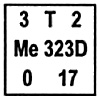
Second Front allows heavy transports to carry mountain and airborne headquarters as well as most non-motorized, nondivisional units. This is entirely correct for the Allies as they had no need to transport artillery pieces and the like by air, except to support the airborne forces. Thus the Hamilcar's heaviest load was 16,000-pound (7250 kg) Tetrarch light tanks delivered during the Normandy landings. Now even a 155mm howitzer only weighs about 12,000 lbs. (5440 kg) so why can't you deliver divisional artillery, for example, headquarters units in Europa terms, via heavy transports like the Germans did?
Quite a lot of the heavier weapons in Wehrmacht's inventory were flown by the Me 323 to Tunisia as it was far safer than the sea route, until the Allies 0 17 neared Tunis itself, albeit a very uneconomical means of delivery. The Me 323 could carry some 25,000 pounds (11,330 kg) of cargo, enough for an 88 and its half-track primemover! The Me 321 glider could carry nearly 50,000 pounds (22,660 kg) of cargo, but it was exceedingly difficult to tow at the higher weights.
The Germans did this all the time as they often operated with extremely tenuous supply lines (Can you say North Africa or Moscow?). In fact a number of Me 321s were deployed to Russia in the fall of 1941 to support the advance and, aside from air landing troops to take the Baltic islands off the Estonian coast, that's exactly what they did.
-
Introduction
Gunfire from the Wine-Dark Sea
Do Frog Legs Taste Better than Crow?
Old Johann Heinrich was an Eisenbahn Mann
Heavy Transports
The Jets Revisited
Back to Europa Number 56 Table of Contents
Back to Europa List of Issues
Back to MagWeb Master Magazine List
© Copyright 1997 by GR/D
This article appears in MagWeb (Magazine Web) on the Internet World Wide Web. Other military history articles and gaming articles are available at http://www.magweb.com